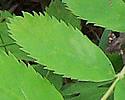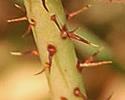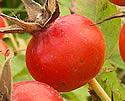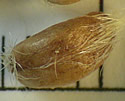 |
Canku Ota
|
 |
|
(Many Paths)
|
||
|
An Online Newsletter
Celebrating Native America
|
||
|
February 2021 - Volume
19 Number 2
|
||
|
|
||
|
Prairie Rose
Rosa arkansana |
||
|
by Minnesota Wildflowers
|
||
|
Detailed Information
 1
to 4 flowers typically form at tips of new, ground shoots and occasionally
at tips of second year lateral branches of older woody stems. Flowers
are 1½ to 2 inches across with 5 broad, rounded petals with
wavy edges often notched at the tip. The color can range from nearly
pure white to deep rose pink and often strongly bi-colored. Numerous
yellow stamens surround the shorter styles in the center. The sepals
are narrow lance-like, ½ to just under 1 inch long, rounded
at the base, the outer surface smooth. Flower stalks are smooth. 1
to 4 flowers typically form at tips of new, ground shoots and occasionally
at tips of second year lateral branches of older woody stems. Flowers
are 1½ to 2 inches across with 5 broad, rounded petals with
wavy edges often notched at the tip. The color can range from nearly
pure white to deep rose pink and often strongly bi-colored. Numerous
yellow stamens surround the shorter styles in the center. The sepals
are narrow lance-like, ½ to just under 1 inch long, rounded
at the base, the outer surface smooth. Flower stalks are smooth.
Leaves and stem:
Fruit: Fruit type:
|
||||||||||||||||||||
|
|
||
| Canku Ota is a free Newsletter celebrating Native America, its traditions and accomplishments . We do not provide subscriber or visitor names to anyone. Some articles presented in Canku Ota may contain copyright material. We have received appropriate permissions for republishing any articles. Material appearing here is distributed without profit or monetary gain to those who have expressed an interest. This is in accordance with Title 17 U.S.C. Section 107. | ||
|
Canku Ota is a copyright ©
2000 - 2021 of Vicki Williams Barry and Paul Barry.
|
||
 |
 |
|
|
The "Canku
Ota - A Newsletter Celebrating Native America" web site and
its design is the
|
||
|
Copyright ©
1999 - 2021 of Paul C. Barry.
|
||
|
All Rights Reserved.
|
||


 Leaves
are alternate and compound with 9 to 11 leaflets, occasionally 7.
Leaflets are ¾ to 1¼ inches long and ½ to ¾
inch wide, generally elliptic or widest above the middle (obovate),
rounded or blunt at the tip, with serrated edges except at the base.
Leaf stalks are ½ to just over 1 inch long and hairy. 2 wing-like
appendages (stipules) are at the base of the stalk, and sometimes
have a few scattered glands around the edge of the tip end. Upper
leaf surface is dark green and hairy to smooth, the underside light
green and hairy.
Leaves
are alternate and compound with 9 to 11 leaflets, occasionally 7.
Leaflets are ¾ to 1¼ inches long and ½ to ¾
inch wide, generally elliptic or widest above the middle (obovate),
rounded or blunt at the tip, with serrated edges except at the base.
Leaf stalks are ½ to just over 1 inch long and hairy. 2 wing-like
appendages (stipules) are at the base of the stalk, and sometimes
have a few scattered glands around the edge of the tip end. Upper
leaf surface is dark green and hairy to smooth, the underside light
green and hairy. First
year flowering stems are green turning red the following season,
mostly simple, typically spreading to ascending. Lateral branches
are produced on older woody stems and are weak and often don't flower.
Both first and second year growth bear stiff, slender bristles of
unequal size.
First
year flowering stems are green turning red the following season,
mostly simple, typically spreading to ascending. Lateral branches
are produced on older woody stems and are weak and often don't flower.
Both first and second year growth bear stiff, slender bristles of
unequal size. The
round berry like fruits (rose hips) are about ½ inch in diameter,
turning bright red in late summer.
The
round berry like fruits (rose hips) are about ½ inch in diameter,
turning bright red in late summer. Inside
the hips are several light brown seeds that are oval to egg-shaped,
about 1/6 inch long, with a few long hairs at the ends and across
the surface.
Inside
the hips are several light brown seeds that are oval to egg-shaped,
about 1/6 inch long, with a few long hairs at the ends and across
the surface.